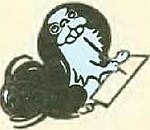
THERE are still a few days for those of you who got on soap boxes during the war and made minute speeches about the English speaking races, to view the Retrospective Exhibition of British Paintings at the Grand Central Art Galleries. If you are a person who quit trading with the corner grocer because you believed him a German spy, you will enjoy this exhibit. We can’t imagine how one can enjoy it on any other grounds save those of intense Anglicism. A placard with sufficient fairness warns you that this exhibit is held in the interest of further cementing the bonds of the English speaking races.
Getting back to the war again, we personally feel that most of this exhibit was chosen by a committee composed of the Kaiser, the Krupps and the other princes at liberty. Oh yes, the dollar you pay for admission goes to the “Endowment Fund” of the Grand Central Galleries, if you are interested in endowment funds. The catalogues are one dollar, too, so we can’t tell you much about the roster.
On a canvas forty feet square, more or less, there is a portrait of an English lady on horseback with all England in the valley back of her. This has the important spot in the show. Down one corridor, in a corner, you will be able to find Hogarth’s “The Rake’s Progress.” If you care for anything later than Ingres, stay at home and let the cement of the English speaking races crumble away.
Speaking of Zuloaga, as half New York did the last month, one must not despise publicity. If one had time he might evolve a formula for successful shows which would run something on this order: “Better a third rate artist and a first rate publicity man than a first rate artist and no publicity man at all.” They do say, around about the galleries that there is considerable pique over the tremendous fuss made over the Spaniard’s work. There is a moral in it for the American gallery. A race reared on billboards, nourished on Mellen’s Food, Quaker Oats and washed with Ivory soap, will never seek its art in dark corners. The members of that race wish to be told about it, they wished to be “sold,” as every good Rotarian knows. Let them read about it in the Sunday papers and on the billboards and they will walk a mile for it, even though it be art.
An artist standing in front of the Michael Strange portrait at the Zuloaga show was explaining to his companion that the legend existed that the reason Zuloaga did not paint so well now as in his earlier days, was that he only took up brush when his son wanted money to buy a new motor car. The companion gazed at the bean-pole Hamlet again and opined that young Zuloaga probably decided on a Ford.
The Society of Independent Artists begins its show at the Waldorf, March 6. Here is a group that knows the value of publicity. Perhaps it is never a very attractive goat chosen for the sacrifice, but it suffices to get on the front page and bring thousands to the show. Despised by the old guard, perhaps, but containing always something of merit. A shrewd collector may save himself much by purchasing at the Independent rather than waiting until the artist has gained partial recognition and moved up Fifth.
And speaking of the lower rungs of the ladder, someone with a keen business sense (probably the publicity man), has inaugurated an exhibit at Macy’s. Yes, the same place that you get your tinware and your blankets. It is on the sixth floor, buried away of course, and a great secret to all attendants and elevator men.
But as that is the same floor that bears the Sistine Madonna prints and the college pennant pillows, just say “Art” and you will find it. The pictures are small and vary in price from $24.74 to $99.50. There are enough unknowns in the list of forty-two to interest the gambler. And there are some by such good painters as Edgar Melville Ward, Emile Grupper, Richard Lahey, H. E. Schnakenberg, Lucile Blanch and Jane Peterson, who by the way has just sold one of her Turkish sketches to the Brooklyn Museum.
There is always something interesting at Dudensing, patron of the moderns. Perhaps it is the designs of Joseph Stella, always on view or some of his West Virginia drawings. The display is composed of pictures from the League Show.
—Froid


